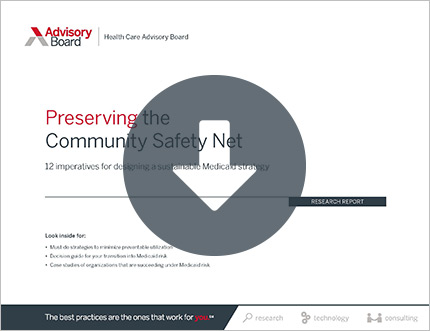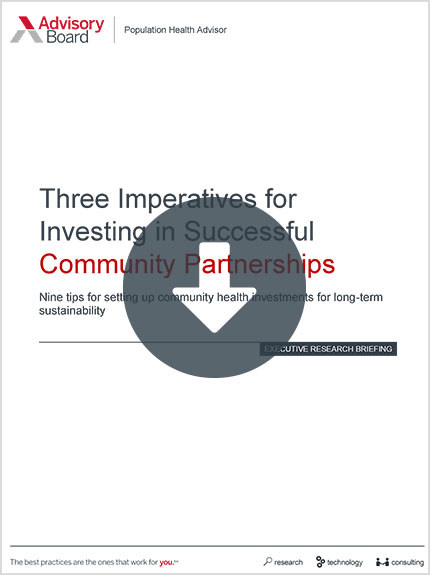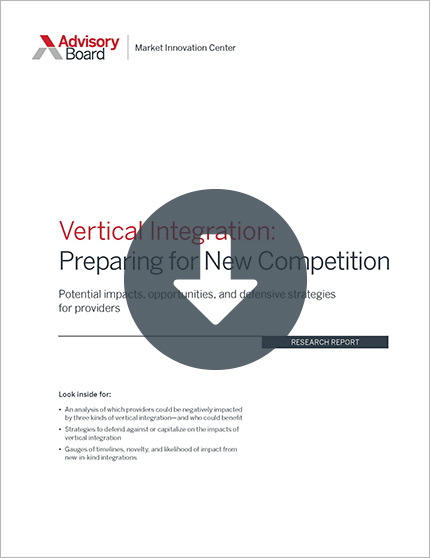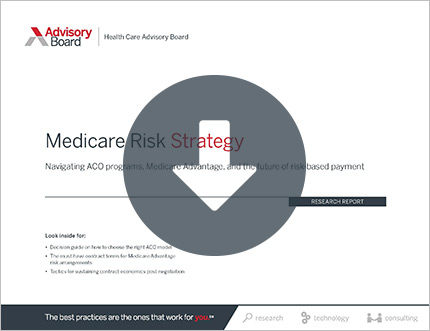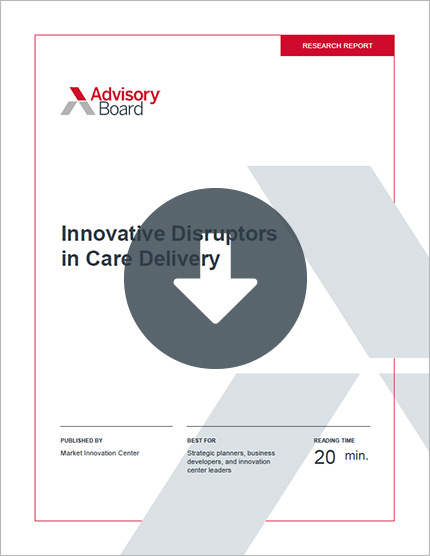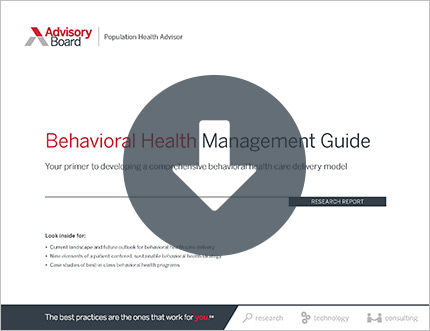Welcome to the "Lessons from the C-suite" series, featuring Advisory Board President Eric Larsen's conversations with the most influential leaders in health care.
In this edition, Sarah Krevans, president and CEO of Sutter Health, talks about what's not in her professional biography, discusses how California's Lake County fires helped define Sutter as a health system, and shares the "very luckiest thing" about herself.
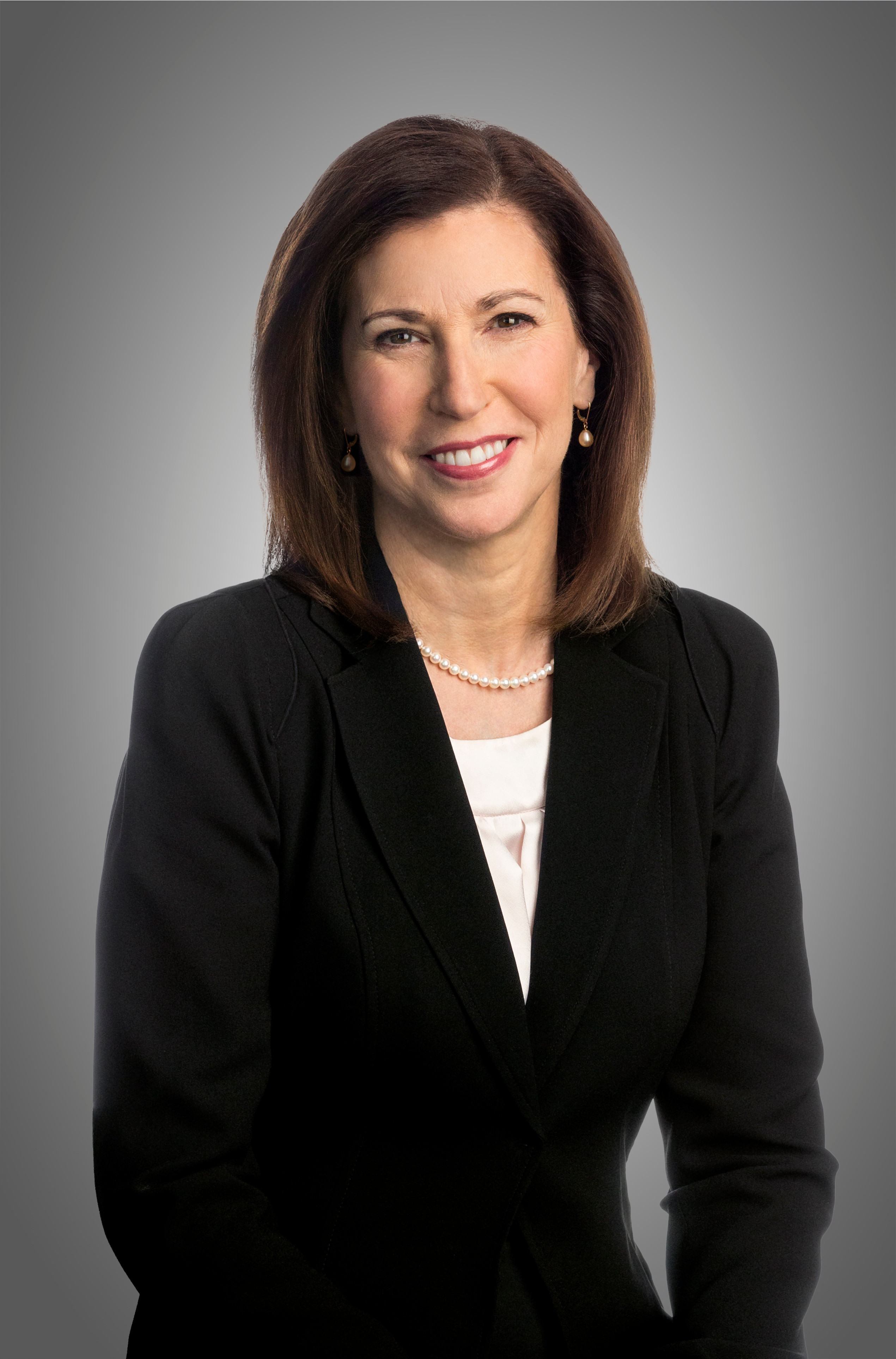
Sarah Krevans, President and CEO of Sutter Health
Question: Sarah, let's start our conversation by highlighting what's not in your bio. I'm generalizing, of course, but the bios of many of your counterpart CEOs start with something along the lines of, "Such and such runs an X billion dollar system, with X number of hospitals, and X number of employees," and so forth—but not yours.
Despite Sutter Health's impressive stats—a $12.7 billion, 24-hospital nonprofit system with more than 53,000 employees—your bio starts unconventionally, with a statement around your passion to serve vulnerable and underprivileged populations. So tell me, what about your career—before Kaiser Permanente, before Sutter—shaped the sort of conviction and idealism that clearly influences you even now?
Sarah Krevans: You know Eric, nobody, when asked what they want to do when they grow up, says, "I'd like to run a health system," right? A kid doesn't even know what it is. And when I was younger, even when I started in the industry, health care systems didn't really exist. But what did exist was an opportunity for somebody like me—an unskilled caregiver at a skilled nursing facility for elderly, mentally ill patients—to observe enormous problems and gaps in care. And these were issues not with the skills and intentions of any individual physician or caregiver, but with the system overall, particularly for the most vulnerable populations, including the poor, the disabled, the mentally ill.
So that experience in the nursing facility definitely fueled my youthful idealism around this very topic. But fast forward all these years later, and here I am: I have the privilege of being a part of a health system that serves more of the poor than anyone else in our Northern California footprint, a health system that in terms of geographic and patient population diversity is a microcosm of health care in the United States. And it's important to me to get back in touch with that idealism. If I have a bad day or week, the best cure is to go out on rounds in one of our medical offices or hospitals because you see people caring for strangers with love and compassion. And then realize we need to get back to work celebrating what's right in healthcare and fixing what needs to be fixed.
Defining a system—in the Lake County fires
Q: Let's talk about Sutter today. You serve an expansive geographic area across Northern California, with a diverse and complex population—a population speaking more than 100 languages, and living in incredibly variable socioeconomic circumstances. On the one hand you cover some of richest counties in the country, and on the other you are the largest provider of indigent care in the state. With this backdrop, how has Sutter evolved to treat this mix of patients and markets? I remember you did a significant restructuring in 2014, moving from five to two regions.
Krevans: The 2014 work was a massive restructuring, and we've continued that evolution. But, you know, I have yet to meet a patient or a patient's family who cares about how we're structured—who reports to who, where the bills go, all of that—and it's amazing to me how many organizations think that matters to their external clients and customers.
Patients care about the care itself, right? So for us, thinking about what it means to be a health system really translates to thinking about every way in which it is better for our patients, their families, and our communities that they're getting care at a system. And a system ensures that people can access things they need—in this case, medical records, appointments, physicians, etc.—when and where they want, in a way they couldn't before. The art is determining what things need to be done locally, what things need to be done as a system, and how can you have that mix be an advantage for your patients in terms of the care they receive.
Q: Let's unpack this idea in more depth, Sarah, because you're getting to the heart of a question that so many health care organizations struggle with: "What does it mean to be a health system?"
Krevans: I agree. This all came to life for me after the fires in Lake County last summer, because those fires posed that exact question, "What does it mean for a rural community like Sutter Lakeside to be part of a health care system?" And what I saw in our response to those fires was the best of both worlds.
When the fires broke out, the CEO at Sutter Lakeside—a young, incredibly energetic guy—literally moved into the hospital with the chief engineer, enduring temperatures in the building of close to 100 degrees. And why were they there? They understood that Sutter Lakeside is very isolated, so if all the systems went down, if they had to throw everything out and start over when the fire was done, it would be weeks or months before the hospital was once again available to that community. So they were doing everything they could do to ensure they could reopen quickly—they actually evacuated at the request of local emergency officials, reopened temporarily, and then evacuated again. So that's the local part of the equation.
But what did it mean that they were part of a system? Well, we'd previously been through the Sonoma County fires, so we knew what to do: We moved all of the phone calls to our call center in Utah and we had physicians doing video visits from other parts of the system. We had physicians and advanced practice clinicians from other Sutter facilities refilling medications in people's charts. We tracked every home care patient. We knew how to work with the pharmacies, and we knew what pharmacy laws changed once the state of emergency was passed. We knew how to get special air filtration systems out into the clinics. You don't tell your home health nurses as they're evacuating their homes "call your patients," but they did; they called every one of their patients to ensure they were alright. So we knew how to respond as a system.
Q: Great example, as it illustrates that balance at play between local and system-wide components in a successful system.
Krevans: Exactly. That's the duality of what we can do locally and as a system. And you know, when I went to Lake County to thank them for what they'd done in the fire, they didn't want to talk to me about that. They wanted to talk about how Lake County has one of the worst life expectancies in California, and that their local interpretation of our mission—to improve the lives of every community we serve—is to change that.
It was very humbling to see, and, to me, that's what we have to have as a system: Local people feeling very empowered and creative, yet still understanding that by working together and being wise about what we standardize, we can benefit the community in a way we can't individually.
Vertical integration
Q: Let’s touch on another aspect of "systemness" that is being discussed these days: vertical integration. So much of what we're seeking to do, especially on the social determinants of health side, is unreimbursed under conventional fee-for-service. And one theory is that if we vertically integrate—offer some kind of provider-sponsored health function—we're empowered and incentivized to offer these services that aren't strictly in our narrow category of "health care." But this strategy is not for the faint of heart, with lots of well-documented missteps.
Sutter has been an innovator on this front—you're one of the few health systems to have launched a de novo health plan: Sutter Health Plus, an HMO with about 80,000 lives. And you've also entered into partnerships with Aetna and, more recently, on Medicare Advantage (MA) with Alignment Healthcare, one of the pioneers in serving complex, polychronic Medicare populations under risk arrangements. What's your goal here?
Krevans: If you think about what our mission is, and how we serve the diversity represented across the United States, there's not going to be one solution for all those patients in all those communities. So our goal is to have affordable, high-quality health care available in the communities that we serve—and that doesn't mean we will always provide all of that care, nor does it mean we will always be the insurer of all that care. We believe that an integrated delivery system, we can partner with patients to make good decisions in a different way than an insurer can, that integrated care makes lots of sense for our patients, and that us bearing financial risk for a portion of our patients is good and appropriate.
So having multiple products and payer relationships makes sense. We need to be deliberate about the different needs of our different customers. For instance, I'm thrilled we just reached our longest-term agreement to date with Anthem Blue Cross, which is our single largest commercial payer, earlier this year.
We participate in numerous PPO products and are also excited about our Sutter Health/Aetna joint venture that's for fully insured and self-insured. Then we have Sutter Health Plus, which is a very traditional HMO product.
With MA, we participate in certain MA plans and hope to continue to do so, and we hope health plans continue to have us in their networks. But MA hasn't been the solution for every patient. Regarding our recent partnership with Alignment, we respect that they have a history, knowledge, and approach that we can really learn from—they bring much more to the table than just getting a license or marketing in a way that complies with all the regulations. They bring a perspective about what really works, particularly for certain segments of the Medicare population, as you pointed out Eric.
We've been taking Medicare risk for quite a while—parts of the system have deep experience with managing MA patients and do it very well. So I think the partnership is about bringing the best of what we both have to offer to Northern California by respecting each other's experience. This partnership is an opportunity to explore how we can spread best practice, which has been a big challenge in health care.
Q: Your past experience on the Medicare risk side is an invaluable guide. So many CEOs I talk with about their MA strategies are frustrated. Part of that frustration goes perhaps to initial, unrealistic expectations on growth when they launch an MA plan—I see a lot of pro formas calling for 5,000 lives in the first year, ignoring the fact that anecdotally the average for year-one sign-ups for provider-sponsored plans is nowhere close to that number. This is a complicated business. You've got a unique perspective on this Sarah coming from Kaiser, and now your experience at Sutter. How is your approach distinct?
Krevans: You know, part of it is being humble about what we know how to do and don't know how to do, which is why we're doing this with a partner. Another part of it is that, unlike some other systems, we don't tell patients, "When you turn 65, join the MA plan or you can't see us anymore." People have to say, "This actually will be better for me"—and that means we have to think about whether what we're going to offer is actually more attractive than staying with us on a fee-for-service basis. And if I'm going to offer an additional benefit, then I have to actually deliver on the care management side to afford that. So that's been the challenge.
Partnerships are not limited to health plans. We also have other ways in which we're reaching the Medicare market. For instance, Stanford has been looking for options about how to manage its own Medicare product, so we're now in their network, and they're in ours, and we've mutually seen growth in that MA plan.
Q: Let’s broaden the conversation a bit from MA and talk about capitation more generally. I often go back to Intermountain's seminal article of a few years ago in Harvard Business Review, positing that once your revenues hit 23% to 29% capitation, you are then incentivized to shift fully to a population-health model. As I look at Sutter, with your medical foundations, medical groups, IPAs, etc., I think you have something on the order of 270,000 lives under full-cap. What percentage of your total revenues are capitated?
Krevans: We're about 10% or 11%. At one point, we were much higher, but it's declined with the growth of self-insured plans and the shrinkage of plans that use an HMO model and then do delegated risk.
And per your comments, Eric, we'd love to have more capitation, because this is a real challenge for our clinicians; the last thing you want a clinician to do is choose a patient's treatment based on his or her insurance coverage. On the other hand, patients need their providers to understand what's covered and not covered for them—if a physician totally ignores it, that's unfair to the patient. Patients don't want doctors ordering something for them that's a non-covered benefit without explaining it to them or telling them about alternatives. So the challenge, particularly given the diversity of our patient population, is what support systems do we need to build around our clinicians, and how can we transparently provide that information to patients, so that the physician can practice medicine and the patient can be fully informed?
Navigating a unique market
Q: Let's talk about the hyper-competitive landscape in Northern California, with its broad array of health systems, all making diametrically different bets—not all of which will pan out successfully—on what it means to be viable going forward.
Krevans: It's a good point, and an incredibly complicated market with a real diversity of players here. So one way to think about it is to ask, "What to date has been good for people in North California?" Because Northern California has some very specific challenges. We're one of the most expensive places to live in the country, and we operate in 11 of 12 of the nation's highest wage markets. And if you look at Medicare, pretty much all the full-service hospitals in California are losing money, and Northern California loses much more money than Southern California because the wage index adjustment doesn't fully account for the wage difference. And there's a total lack of understanding about how much the difference in Medicare payments drives the differences on the commercial side.
So this means we're all facing similar challenges, which are really about how to provide quality, accessible care where the bulk of patients are public beneficiaries who don't pay the full cost of care, all while private insurers and the employers are saying, "Why is this happening?" So that's on the positive side—a shared understanding of the challenges, as well as really great collegiality and cooperation on a number of important community health and policy issues, such as homelessness. On the other hand, we're competitors, and there's a lot of healthy competition in Northern California. And if you look at cost per beneficiary as measured by Medicare, good total cost of care, good utilization management, and good quality in Northern California, we're incredibly proud of how we're doing.
Q: Those specific challenges you list for Northern California—the concentration of expensive cities, the wage index complexities, the insufficiency of government payments—if anything make the urgency around addressing affordability and total-cost-of-care (TCOC) all the greater. Hard to do this transformation in a predominantly fee-for-service environment. How are you thinking about this?
Krevans: This is an interesting question and all the more challenging, Eric, as you point out, when the bulk of your patients are fee-for-service. Part of it is understanding that serving patients on an episodic basis is fee-for-service to you, but your ability to continue serving them and their ability to continue accessing health care really depends on the aggregate system's total cost of care. So the challenge is how to build those things into our relationships with insurers, and particularly with self-insured employers, in a way that works in the short and long run.
Re-ignite the growth engine: 3-part report series
Q: And there's a decent number of people—the walking well, who for 99.9% of their lives aren't anyone's patients—who'd prefer to maintain that episodic approach to care.
Krevans: Absolutely. And thinking about total cost of care for those patients who like to relate to health care in an episodic way is a really interesting challenge, because the systems that have done the best in total cost of care tend to have a single monolithic model or they've taken a single segment of patients, when they reach a certain level of acuity, like a CareMore, and wrap stuff around that. So we've got to find new, different ways that we can think about total cost of care for a large subset of the population who may either be low-risk or rising-risk and whose health-seeking behavior doesn't match what we think of as a total cost of care.
But that said, we do things we don't get reimbursed for—things we do because they're the right thing from a total cost of care perspective, because they build our capability and capacity, and because it's just the right thing to do. For example, we've kept funding our Advanced Illness Management program, which was originally funded by a grant. We're also piloting a 100% virtual practice in Silicon Valley that's managed by a physician from the Palo Alto Medical Group, who's essentially salaried for that care, plus support staff. It's only capitated patients right now, so that we can measure the total cost of care. And it's interesting, because the skeptics said she'd only get young Apple or Google engineers. But this doctor has some unbelievably complex patients, including some who were very high utilizers, whom she's now managing virtually.
Q: This virtual program makes me think of what you previously said about how Sutter isn't trying to "out-invest" the venture capitalists or "out-tech" these trillion-dollar market cap FinTech companies, but rather "translate" these opportunities into partnerships. And you've teamed up innovatively with some of these companies—a voice-enabled artificial intelligence partnership with Apple, and a genomics partnership with UPMC for multiple sclerosis are two examples. I have to think your proximity to Silicon Valley has been a great advantage here. Talk if you would about those partnership opportunities and how you think about partnership generally.
Krevans: You're right that our strategy is not to be a better investor in health care than a venture fund or to be better at inventing things than the talent around us, but to be a really good partner. Now, that doesn't mean we would never invest if it was the only way to get access to a product, or that we wouldn't invent our own creation if we couldn't find somebody to fill a patient's need, but a lot of the things that we've been able to do has been through the "better together" model.
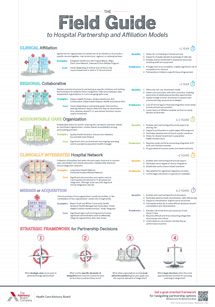
The field guide to hospital partnership and affiliation models
Because we really do have some great opportunities to partner. You know, I'm not going to pretend that every smart, creative person lives in San Francisco and Silicon Valley, but a lot of smart people do, and other people come from all over the country to partner with them. So you’re right, we do have an advantage just in our geographic location. We also have an advantage in terms of diversity: I can start my day in a tiny little town with a critical access hospital and then end my day in our new hospital in San Francisco that offers a complexity of quaternary care that you often don't find outside of an academic medical center. And that diversity is incredible when you're thinking about an entrepreneur at scale, like Google or Apple, because they're not interested in a product that works only for San Francisco or Sacramento—they're thinking much bigger.
But part of recognizing the partnership opportunity here means understanding that some of these pilots will work and some won't. We've got to stop the pilots that don't work and learn from them—that's hard in health care, to stop things once you start them.
Translating personal passions into professional innovation
Q: Sarah, I know one of your personal passions aside from work is around improving the foster care system. If you’re willing to share, I’d love to hear a bit about this. Given your focus on social determinants, I have to think this is one of those "convergence" areas that bring together your professional and personal priorities.
Krevans: You know, the very luckiest thing about me is that I had parents who loved me—and then I was even luckier, because they could afford to give me an education and, if something really bad had ever happened to me or my siblings, they could afford to step in to help us. Compare that with the statistics about children who emancipate from foster care without a permanent attachment: nearly half will be homeless within 18 months; if they're male, in prison; if they're female, pregnant; or some combination of the above. We as a society can see the train coming to hit these kids, and we're not doing everything we can do to stop it.
So foster care is a huge passion for me. In addition to my husband's work as a volunteer court-appointed special advocate, we've personally played a role in the lives of children who've been in the foster care system, whether or not they've been adopted, and through philanthropy. Other than health care, it's our single biggest focus in terms of philanthropy, volunteerism, and advocacy.
And you're right, this does bring together the personal and professional. As health care providers, we sometimes view quality as doing the same thing for everybody, because that means we're treating everybody fairly, but these kids and the families who've stepped up to help them need a whole different kind of support. They have all the issues and challenges any child would have, plus a whole special wraparound set of issues while they are in foster care, once they are adopted, and post-adoption. And they have very specific needs that emerge at different ages—adolescence and young adulthood are particularly vulnerable times from a mental health perspective for children who've been adopted out of foster care or an institutional setting.
Q: Your comments on behavioral health are especially timely—Northern California suffers from a shortage of psychiatrists, psychologists, therapists, etc. And this scarcity is made worse by a real geographic maldistribution; the clinicians we have are not necessarily matching up with where the population needs are. How are you thinking about behavioral health in terms of integrating it into a TCOC framework and across a diverse patient population?
Krevans: So the first thing I'll say is that the way you're referring to it is the politically correct way to refer to it, which is behavioral health. But I could show you data that say that many things we talk about as health—type two diabetes, certain kinds of CHF, etc.—have a higher behavioral component than somebody who has schizophrenia, bipolar disorder, chronic depression, severe anorexia, or many mental health disorders. So I always use the term, "mental health"—ideally, it would just be "health," but then nobody knows what we're talking about.
When we as a system tried to determine where to start, we realized we couldn't do everything—we're not equipped, nor do we have the depth of a provider network, to solve this on our own. So we started with a broad range of things. For instance, we have some in-patient mental health facilities. We're also assessing what we can do to be a responsible part of the conversation around mental health and reducing the stigma of seeking treatment, an effort helmed by the head of our mental health services, and former chair of the California Mental Health Commission, John Boyd. And we're examining how to take better care of our employees and their dependents—issues like physician suicide, workplace wellness, and ensuring people feel they can seek mental health care without it affecting their job.
We've also started helping our primary care physicians with that referral for initial mental health treatment. Because when you talk to primary care physicians about why they don't do depression screening, we learned that it's not because they don't care, but because they don't know what to do when it comes back "yes"—since we've bifurcated mental and physical health care coverage, providers have no idea who to refer because they don't know who's covered by the patient's insurance. So the patient calls his or her mental health provider and gets a list of names, people who may or may not be competent to treat the condition, have availability, or be cash-only—that's a big problem in Northern California.
So we've partnered with Quartet, a provider database and referral system, to make a warm handoff. So if my physician tells me, "Sarah, it would be great for you to see a provider," Quartet steps in and says to me, "Sarah, here are three providers within 10 miles of your home, all of whom are in-network, have agreed to take insurance, and have appointments available withi two weeks."" And then Quartet follows up to see if it actually happened. Now, does it work perfectly every time? No. But is it better? Yes.
Q: Your partnership with Quartet reminds me a bit of Intermountain, which has been embedding mental health into its primary care clinics for years.
Krevans: Yes. We've done some pilots with that as well. But the challenge is, can you scale that? And the answer is no. Are there enough providers in Northern California? No. And, even if we could do that, would it be affordable? No. So this situation is going to involve some creative solutions, and sometimes that's in-person therapy, but not always. I mean, there's some fascinating work that's happened with avatars and teenagers in particular—the kids will tell them things they would never tell a human.
Q: I agree. Your comment on avatars and the preference patients have to talk to a chatbot instead of a human underscore for me how dynamic this space is; Artificial Intelligence and Machine Learning are going to disrupt this profession in profound ways. Some of the work done recently at Stanford suggesting that treating depression through AI-driven cognitive behavioral therapy yields faster improvement than with a therapist alone is a good example.
Krevans: Yes, exactly. And to piggyback on what you said, we recently launched Ada, an AI-driven system that works as an advanced symptom-checker. It changes its answers based on user responses, and it will keep getting better, because it's continuously learning, comparing backend data on what actually happened to frontend data. And unlike other symptom checkers, the key difference is that it will actually talk about what to do next—it was developed to reach the millions of people who will never see a physician in other countries, so the system's end answer isn't just, ""Here's the best you can do at home, but ""If you need to see somebody, here's what should happen.""
Wrapping up
Q: As we draw to a close, Sarah, I'd like to ask you one of my favorite questions: As you think retrospectively on all the things you've been privileged to do, what are you most grateful for?
Krevans: I'm grateful that I've been given an opportunity to make a difference. Because this doesn't happen by accident, right? There are a lot of people who are as smart or smarter, just as hard working or harder working, who haven't had the opportunities I have had. And some of those opportunities I've had have been by an accident of being born into the family I was born into. So you have to start by being grateful for the fact that you were given a good start in life, not to mention the opportunities I've had along the way in terms of mentors and colleagues.
Q: And what are you doing now that you're most passionate about?
Krevans: I've been thinking a lot about leadership. Because I hope that 10 years from now, health care—while provided with the same values of caring and compassion and quality—is delivered in a dramatically different way. So I think one of the biggest challenges we have right now is figuring out how we keep our organizations—ourselves and our leaders—focused on the right thing.
And that means I'm passionate about figuring out how to be the best version of myself every day, and how I ensure that all of our leaders do that too. Because every employee survey will tell you that frontline clinical leadership really matters. So how do we support those frontline leaders? How do we ensure that people are thinking about who we're here to serve? That's what I'm really passionate about.
Q: Then let's close on this: You say you hope health care will be dramatically different in 10 years—what's your vision of that?
Krevans: So if you think about what people want, I don't think that's going to change—but how it manifests itself, that’s what we need to catch up with. People want health care to be affordable, accessible, and personalized. But they also want to take advantage of mass customization; it can't be slow—it's got to be instantaneously personalized. The key here is understanding that getting practitioners to practice the same for everybody is not good enough—they have to want an equally good outcome for everyone, and they have to know how to do it.
So what does it look like in 10 years? I think it's bringing together digital technology, genomics, our knowledge of social determinants, and clinical medicine—including mental health care—instead of thinking of these as separate things. And it's going to be bringing those things together in really different ways. We need to bring together what's already working in health care, or already working in other industries, and ask, ""Well, what would that look like in mental health? In primary care? In diversity and inclusion?"" Even if all we did was get health care to the point that so many consumer-focused industries are at now, then we'd be doing a lot better than we are today.
Get more lessons from the C-suite
Check out Eric's recent must-read interviews with top hospital and health system leaders:
Brian Gragnolati plans to make Atlantic Health System 'indispensable.' Here's how.
Brian Gragnolati, president and CEO of Atlantic Health System, talks about his priorities as chair of the American Hospital Association, getting his first role as a hospital president while he was still in his twenties, and how he plans to make Atlantic an ""indispensable"" system. Read our interview with Gragnolati.
Marc Harrison promised to turn Intermountain into a 'Tesla.' He wasn't kidding.
Marc Harrison, president and CEO of Intermountain Healthcare, talks about Intermountain's recently announced strategic reorganization, previews the launch of a ""virtual hospital"" to better serve rural communities, and shares the surprising worry that keeps him up at night. Read our interview with Marc.
'A little bit of a pirate': How Kelby Krabbenhoft built a $6B system—and where he's taking Sanford next
Kelby Krabbenhoft, president and CEO of Sanford Health, talks about the unprecedented CEO-philanthropist partnership behind Sanford's rapid growth, why a successful leader needs to be ""a little bit of a pirate, and the merger that will make Sanford a nearly $6 billion health system. Read our interview with Kelby.
Subscribe to At the Helm
To get more of our top insights for CEOs and other C-suite executives, make sure you're subscribed to the ""At the Helm"" blog.
"
Don't miss out on the latest Advisory Board insights
Create your free account to access 2 resources each month, including the latest research and webinars.
Want access without creating an account?
You have 2 free members-only resources remaining this month remaining this month.
1 free members-only resources remaining this month
1 free members-only resources remaining this month
You've reached your limit of free monthly insights
Become a member to access all of Advisory Board's resources, events, and experts
Never miss out on the latest innovative health care content tailored to you.
Benefits include:
You've reached your limit of free monthly insights

